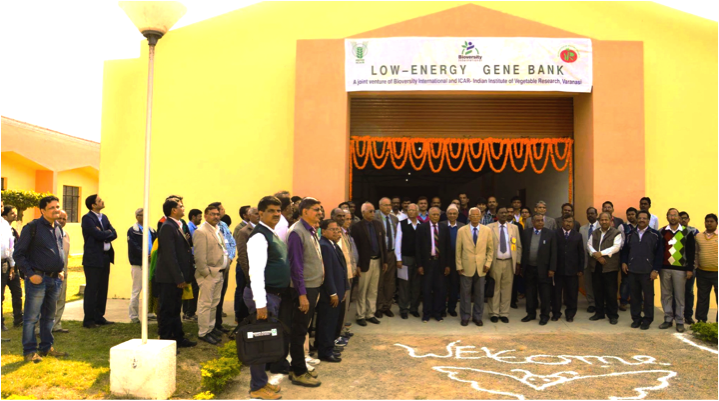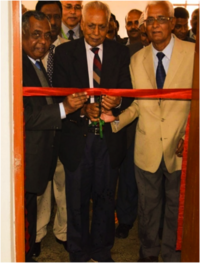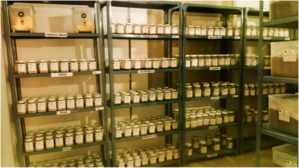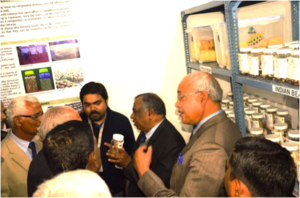Opening the doors to India's first low-energy genebank

Bioversity International scientists report from India on the opening of the first low-energy genebank, inaugurated as part of the National Symposium on Vegetable Legumes for Soil and Human Health.
Bioversity International scientists Prem Mathur and Arnab Gupta , with Sonal Dsouza, report from India on the opening of the country’s first low-energy genebank.
Genebanks traditionally keep seeds in safe storage, using cold temperatures to prolong the seeds’ shelf life. This vital role that genebanks play in food security efforts, ensures that crop varieties can be safeguarded for the future, and enable research on finding varieties that have high yields, thrive under changing climatic conditions, are nutritious, and are resistant to pests and diseases. But genebanks can be costly to run, and can be unreliable when power supplies are uncertain.
A new method of dry seed storage is set to offer a much cheaper and more reliable alternative. India has just opened the doors to its first low-energy genebank which uses an innovative technique based on desiccants to dry vegetable seeds for storage – a technique that requires very little power to operate. Vegetable crops are important for food security, contributing to nutrition and incomes, but the seeds are often stored by farmers in their own homes meaning many can be lost or damaged due to poor storage conditions and challenges like insect infestation. Having this backup is vital for long-term food security.

The genebank, established by Bioversity International in collaboration with the Indian Institute of Vegetables Research (ICAR), Varanas, will adopt this new technique, using a desiccant to absorb the moisture contained in the seeds which is an effective way to store them. Dried seeds are also completely resistant to insect infestation.
The expertise that we brought to developing this method is awareness about the importance of avoiding moisture in seed storage. We supplied drying beads made of zeolite that absorb moisture. We chose zeolite at it contains minerals that absorb water at normal conditions and desorb water at temperatures above 200°C. This means they are reusable - you just need to heat the zeolite beads to release the water and then after cooling they are ready for use again. We also supplied airtight containers that keep the dry seeds dry and built capacity on how to store the seeds effectively. So the concept is to “make them DRY and keep them DRY”. We taught them how to use this technology to store germplasm.
Bioversity International has been using this technique for around two years at community seedbanks in rural areas of India, like Imliakoder (Balrampur District, Uttar Pradesh) and Tehkapal (Bastar District, Chhattisgarh). It is an important step to apply the technology to a genebank at the National Research Institute, where many different seeds samples are kept for very long-term storage. At the community seedbank level, there is usually a higher volume of each seed, and storage is more medium-term.

The genebank was inaugurated as part of the National Symposium on Vegetable Legumes for Soil and Human Health. Dr. Prem Mathur, Regional Representative, Central and South Asia, Bioversity International who attended the opening commented: “The low-energy genebank will play a pivotal role in empowering smallholder farmers to adapt to today’s production challenges, including climate change and pest and disease outbreaks, by making diverse germplasm available to them.”
Nearly 5000 germplasm accessions of 34 vegetable crops will be stored at the genebank. It also has the capacity to upscale storage by five times.
Prem Mathur, Arnab Gupta and Sonal Dsouza
Further reading:
First low-energy genebank inaugurated at ICAR IIVR Varanasi (featured on Indian Institute of Vegetable Research website)
Additional Information:

The Low-Energy Gene Bank was inaugurated on 13 February 2016 by Dr. Kirti Singh, Former Chairperson of Agricultural Scientists Recruitment Board, ICAR, New Delhi. The other guests included Dr. B Singh, Director, ICAR - Indian Institute of Vegetable Research, Dr. G Kaloo, Former Director, ICAR - Indian Institute of Vegetable Research and Dr. Prem Mathur, Regional Representative, Central and South Asia, Bioversity International.
This work is carried out through the Bioversity International's Effective Genetic Resources Conservation and Use Initiative and as part of the CGIAR Research Program on Climate Change, Agriculture and Food Security
Photos top to bottom:
The Low-Energy Genebank set up at ICAR-IIVR, is the first of its kind. Credit: Indian Institute of Vegetable Research/ Dr. S. K. Tiwari
The genebank inaugurated by Dr. Kirti Singh in the presence of Dr. Prem Mathur and Dr. G Kaloo. Credit: Indian Institute of Vegetable Research/ Dr. S. K. Tiwari
Vegetable germplasm stored in the genebank. Credit: Bioversity International/ Arnab Gupta
Dr. Prem Mathur explaining the technicalities of the genebank. Credit: Indian Intstitute of Vegetable Research/ Dr. S. K. Tiwari
